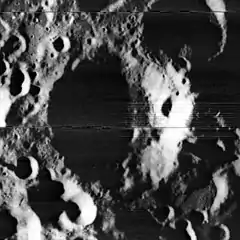 Lunar Orbiter 1 image | |
| Coordinates | 11°00′S 149°00′W / 11.0°S 149.0°W |
|---|---|
| Diameter | 60 km |
| Depth | Unknown |
| Colongitude | 149° at sunrise |
| Eponym | Il'ya I. Mechnikov |

Mechnikov is an impact crater on the far side of the Moon. It is located just to the northeast of the much larger walled plain Galois, being separated by a stretch of irregular terrain about 20–30 km in width.
This is a roughly circular crater that has undergone a moderate amount of impact erosion, but is still relatively intact. Attached to the exterior along the northeast are the satellite craters Mechnikov C and Mechnikov D. There is a small crater in the western part of Mechnikov's interior floor.
Mechnikov is a crater of Nectarian age.[1]
A small crater along the northeast rim of Galois has a small ray system. Ray material from this crater crosses the interior of Mechnikov in a series of streaks that are radial to the impact, producing a fan-like appearance.
Satellite craters
By convention these features are identified on lunar maps by placing the letter on the side of the crater midpoint that is closest to Mechnikov.
| Mechnikov | Latitude | Longitude | Diameter |
|---|---|---|---|
| C | 9.9° S | 148.0° W | 35 km |
| D | 10.2° S | 147.2° W | 53 km |
| F | 11.3° S | 145.0° W | 30 km |
| G | 11.8° S | 146.6° W | 17 km |
| U | 10.6° S | 150.9° W | 30 km |
| Z | 9.3° S | 149.2° W | 21 km |
References
- ↑ The geologic history of the Moon. USGS Professional Paper 1348. By Don E. Wilhelms, John F. McCauley, and Newell J. Trask. U.S. Government Printing Office, Washington: 1987. Table 9-4.
- Andersson, L. E.; Whitaker, E. A. (1982). NASA Catalogue of Lunar Nomenclature. NASA RP-1097.
- Blue, Jennifer (July 25, 2007). "Gazetteer of Planetary Nomenclature". USGS. Retrieved 2007-08-05.
- Bussey, B.; Spudis, P. (2004). The Clementine Atlas of the Moon. New York: Cambridge University Press. ISBN 978-0-521-81528-4.
- Cocks, Elijah E.; Cocks, Josiah C. (1995). Who's Who on the Moon: A Biographical Dictionary of Lunar Nomenclature. Tudor Publishers. ISBN 978-0-936389-27-1.
- McDowell, Jonathan (July 15, 2007). "Lunar Nomenclature". Jonathan's Space Report. Retrieved 2007-10-24.
- Menzel, D. H.; Minnaert, M.; Levin, B.; Dollfus, A.; Bell, B. (1971). "Report on Lunar Nomenclature by the Working Group of Commission 17 of the IAU". Space Science Reviews. 12 (2): 136–186. Bibcode:1971SSRv...12..136M. doi:10.1007/BF00171763. S2CID 122125855.
- Moore, Patrick (2001). On the Moon. Sterling Publishing Co. ISBN 978-0-304-35469-6.
- Price, Fred W. (1988). The Moon Observer's Handbook. Cambridge University Press. ISBN 978-0-521-33500-3.
- Rükl, Antonín (1990). Atlas of the Moon. Kalmbach Books. ISBN 978-0-913135-17-4.
- Webb, Rev. T. W. (1962). Celestial Objects for Common Telescopes (6th revised ed.). Dover. ISBN 978-0-486-20917-3.
- Whitaker, Ewen A. (1999). Mapping and Naming the Moon. Cambridge University Press. ISBN 978-0-521-62248-6.
- Wlasuk, Peter T. (2000). Observing the Moon. Springer. ISBN 978-1-85233-193-1.